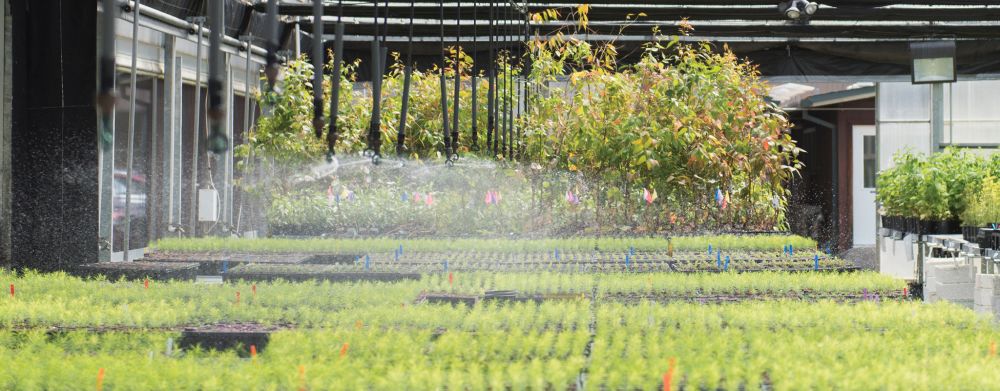
Whether you grow tomatoes or trees, the biological principles and techniques are similar. The only difference, according to Carlos Gonzalez-Benecke, an assistant professor of silviculture and director of the Vegetation Management Research Cooperative (VMRC) at Oregon State University, is the scope of the work.
Working together with associate director Maxwell Wightman, Gonzalez-Benecke manages a VMRC research program that focuses on forest regeneration, including seedling success, plant competition, vegetation control and early growth of forest stands. The goal of the VRMC is to design management systems that integrate the best available science with the practical needs of cooperative members to successfully establish Pacific Northwest forests.
Gonzalez-Benecke carries out much of his work in his greenhouse on campus. With the help of former interim dean Anthony S. Davis, Gonzalez-Benecke transformed the space when he arrived as director of the VRMC in 2015. The greenhouse is designed to ensure seedlings receive what they need to thrive, like water, nutrients and radiation, but is flexible enough to create different growth scenarios for seedlings.
“We wanted to be able to manipulate factors like water, nutrients and radiation in the greenhouse to see how they affected the seedlings,” he explains. “This is why we installed an extensive irrigation system, as well as fixed the roof which allows us to better adjust environmental conditions inside the greenhouse. We can provide more light, or provide a total blackout in certain sections of the greenhouse.”
Gonzalez-Benecke and his team nurture seedlings under various conditions to measure growth, resilience and the effects of different environmental scenarios. Then they turn their focus to tracking performance in the field, studying early seedling establishment and tracking the variables involved in each seedling’s growth pattern. Some of the seedlings Gonzalez-Benecke tracks are ones he has grown himself. Others, he receives from nurseries. The data is used to inform future forest regeneration research.
Another part of his work is in the lab, characterizing genotypes and examining characteristics like their resistance to cold and drought, which, according to Gonzalez-Benecke, is critical information to inform our present and future.
Gonzalez-Benecke also studies how to optimize herbicides for vegetation control, applying mathematical models and algorithms to understand treatment effects. Using a wide range of soil and climatic conditions, he studies how vegetation management treatments impact several aspects of forestry in the Pacific Northwest.
“Vegetation control is very site-specific, and each site has a specific climate, type of soil and varying amount and composition of competing vegetation. The question you ask yourself is: ‘how can I generalize and extrapolate data from each of these sites to inform results and understanding of other sites?’” Gonzalez-Benecke asks.
Studying the specific variables present at each vegetation site produces site-specific results and guidance. Then from those particular results, Gonzalez-Benecke creates a general model.
“It’s almost like a formula or template is produced so that, in the future, for each site, you can answer the specific question: What should I do and what will be the response?” Gonzalez-Benecke explains.
At times, Gonzalez-Benecke feels like a symphony conductor or a musician in the studio because by changing site quality, he can change the “tune” or “song” of the site.
“I can adjust the levers like playing a game or modulating a tune of music,” Gonzalez-Benecke explains. “I can ask how would doing one thing affect the song that’s played or the music that’s heard? What if, for example, we do nothing and just plant? What if we add water? What if we add fertilizer? And what does this all mean in a changing climate?”
The application of techniques and technology that VRMC employs is valuable for growing trees and managing vegetation. It is also vital for other ecological implications, like assisted migration – plants moving geographic location as the climate shifts – as it is deeply centered around the vulnerabilities and probabilities of risk and the biological reaction of responses.
When Gonzalez-Benecke arrived at OSU in 2015, there were twelve members in the cooperative. The VRMC now has seventeen members with additional companies, both large and small, expressing interest in joining.
“The growth in membership over the last few years expanded the area of influence of our research to more than 10 million acres of forests in the western United States,” Gonzalez-Benecke says.
This story was part of the College of Forestry’s 2019-2020 Biennial Report.

